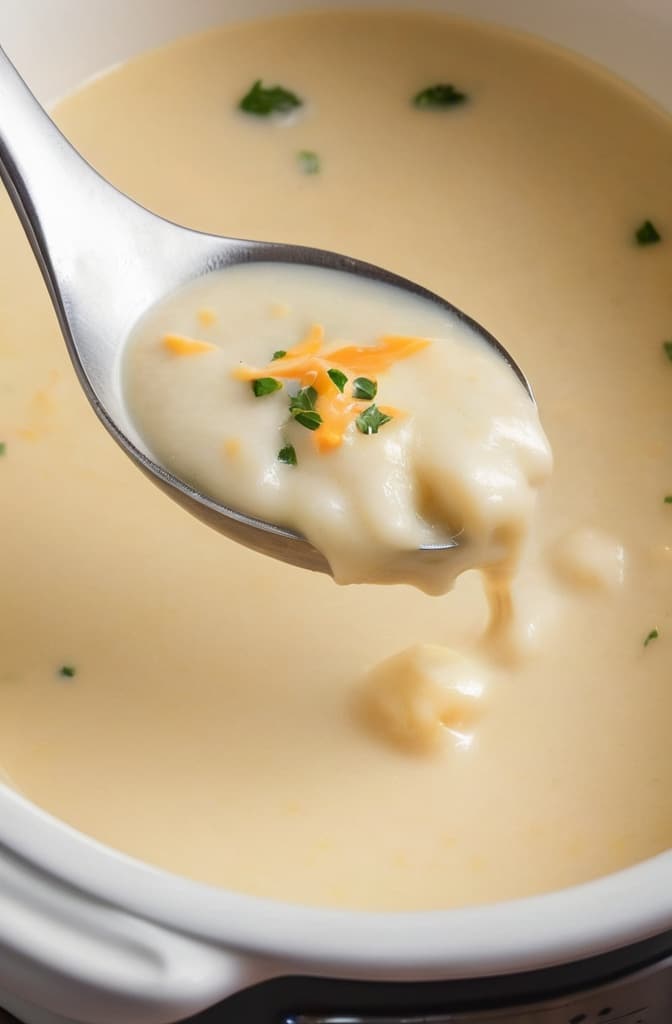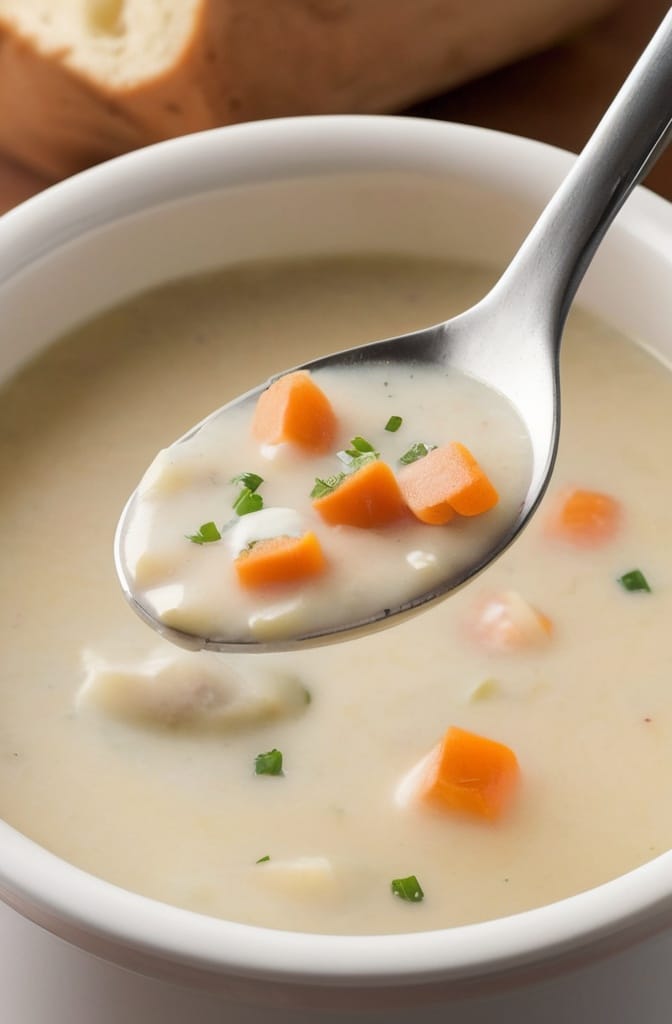There’s somethin’ magical about walking through your front door after a long day and being greeted by the comforting aroma of potato soup that’s been simmering away in your crock pot. I still remember the first time I made this dish it was during a particularly harsh winter in Minnesota, and that steaming bowl of creamy potato goodness literally warmed my soul. Potato soup isn’t just food; it’s a hug in a bowl. And when made in a slow cooker? Well, that’s just kitchen genius at its finest.
Crock pot potato soup stands out from other soup recipes because it transforms humble ingredients into something extraordinary through the low, slow cooking process. The potatoes break down just enough to create a naturally creamy texture, while still maintaining some structure. Unlike its stovetop counterpart, which requires babysitting and stirring, this hands-off approach infuses flavors more deeply while you’re off living your life. It’s the perfect marriage of convenience and culinary excellence.
Ingredients & Substitutions
Core Ingredients
- 2 pounds Yukon Gold potatoes, peeled and diced into 1-inch cubes
- 1 large yellow onion, diced
- 3 cloves garlic, minced
- 4 cups chicken broth (or vegetable broth)
- 2 tablespoons butter
- 1 cup heavy cream
- 8 ounces cream cheese, softened and cubed
- 1/2 pound bacon, cooked and crumbled (reserve some for garnish)
- 1 cup shredded cheddar cheese, plus extra for garnish
- 3 tablespoons all-purpose flour
- 1 teaspoon dried thyme
- 1/2 teaspoon dried oregano
- Salt and freshly ground black pepper to taste
- 1/4 cup chopped fresh chives for garnish
The choice of potatoes here ain’t random. Yukon Golds strike the perfect balance they’re waxy enough to hold some shape but starchy enough to help thicken the soup naturally. Russets would break down too much, turning your soup into mashed potato soup (which, to be fair, ain’t terrible either). Red potatoes will work in a pinch, but they’ll maintain more structure and give less creaminess.
For those with dietary restrictions, several modifications can be made without sacrificing flavor. Lactose-intolerant? Replace the heavy cream with full-fat coconut milk and use dairy-free cream cheese. The slight coconut flavor actually adds an interesting dimension. Vegetarians can obviously skip the bacon and use vegetable broth instead of chicken—mushroom broth works particularly well, adding an earthy umami character. For a gluten-free version, substitute the all-purpose flour with cornstarch (about 2 tablespoons) or arrowroot powder.
The bacon provides a smoky, savory note that elevates this soup from good to exceptional. I prefer applewood-smoked bacon for its subtle sweetness, but any quality bacon will do. For a less conventional but equally delicious option, smoked paprika (about 1 teaspoon) can provide similar smoky notes for those avoiding meat.
Step-by-Step Instructions

Preparation
- Begin by preparing your vegetables. Dice the potatoes into uniform 1-inch cubes this ensures they’ll cook evenly. Pro tip: don’t rinse your potatoes after cutting; the surface starch contributes to the soup’s thickness. A common mistake is cutting the potatoes too small, which can cause them to disintegrate completely during the long cooking process.
- In a large skillet, cook the bacon until crispy. Remove the bacon to a paper towel-lined plate, then crumble once cooled. Reserve about 2 tablespoons of the bacon fat and sauté the diced onion in it until translucent, about 5 minutes. Add the minced garlic and cook for another 30 seconds until fragrant. This pre-cooking step releases the aromatics’ flavors more effectively than adding them raw to the crock pot.
- Transfer the onion-garlic mixture to your slow cooker. Add the diced potatoes, dried herbs, salt, pepper, and chicken broth. The broth should just barely cover the potatoes if it doesn’t, add a bit more. Cover and cook on low for 6-7 hours or on high for 3-4 hours. For a deeper flavor profile, consider adding a parmesan rind to the broth while cooking (remove before serving).
Creating the Creamy Base
- About 30 minutes before serving, in a small bowl, whisk together the flour and 1/2 cup of heavy cream until smooth. This creates a slurry that will thicken your soup without formin lumps. Pour this mixture into the crock pot, stirring gently to combine. For a richer version, replace part of the heavy cream with half-and-half.
- Add the softened cream cheese and butter, stirring until melted. This is where the magic happens—the cream cheese adds a tangy richness that elevates this soup above other recipes. If your cream cheese isn’t softening properly, cut it into smaller pieces and let them sit in the hot soup for a few minutes before stirring.
- Gently stir in the remaining heavy cream and about 3/4 of the crumbled bacon (reserve the rest for garnish). Add the shredded cheddar cheese and stir until completely melted. Cook on high for an additional 15 minutes. If the soup is too thick for your liking, add more broth; if too thin, mix another tablespoon of flour with a bit of cold water and stir it in.
Finishing Touches
- Before serving, taste and adjust seasoning. The soup often needs more salt and pepper than you might expect—potatoes absorb a lot of salt during cooking. For an added dimension, a splash of hot sauce or a squeeze of lemon juice can brighten all the flavors without making the soup spicy or sour.
- Serve hot, garnished with reserved crumbled bacon, additional shredded cheese, chopped chives, and a dollop of sour cream if desired. For an indulgent variation, top with buttery croutons or even a small drizzle of truffle oil for special occasions.
Cooking Techniques & Science
The slow cooker method for potato soup isn’t just convenient it fundamentally changes the character of the dish compared to stovetop versions. The extended, gentle heat allows the potatoes to release their starches gradually, creating a naturally thicker base without requiring excessive flour or cream. This same gentle heat prevents the dairy components from separating or curdling, a common issue when making cream soups on the stovetop.
Potatoes undergo fascinating transformations during slow cooking. Their cell walls gradually break down, releasing amylose (a type of starch) that thickens the surrounding liquid. However, the key is maintaining some cellular integrity so the potatoes don’t completely dissolve. Yukon Golds excel here because they contain a moderate amount of amylopectin (another type of starch) that helps them hold there shape while still contributing creaminess.
The order of operations matters significantly in this recipe. Adding the dairy components too early would cause them to separate during the long cooking process. Instead, we add them toward the end, allowing them to melt into the already-flavorful soup base. Similarly, the flour slurry goes in after the potatoes have softened, ensuring it distributes evenly without creating lumps or a pasty texture.
A 6-quart oval slow cooker works best for this recipe, providing adequate space for the ingredients while allowing proper heat circulation. The low setting (around 200°F) is ideal for developing flavors without aggressive boiling that could break down the potatoes too much. If using a newer model with higher temperature settings, you might need to reduce the cooking time slightly.
Serving & Pairing Suggestions

Presentation elevates this humble soup to dinner party worthy status. Serve it in pre-warmed bowls nothing ruins a potato soup faster than a cold bowl that congeals the creamy texture. Create a “garnish bar” allowing each person to customize their bowl with toppings like extra bacon, chives, cheese, croutons, or even unexpected additions like roasted garlic, crispy fried shallots, or everything bagel seasoning.
The soup’s texture should be velvety but with some small potato chunks remaining for textural contrast. If serving for a formal occasion, consider passing the soup through a fine-mesh strainer for the smoothest possible consistency, then adding back some diced potatoes that were reserved and separately boiled.
For a complete meal, pair this rich soup with contrasting flavors and textures. A crisp, acidic salad with vinaigrette dressing cuts through the creaminess perfectly try arugula with lemon dressing and shaved parmesan. For bread, a crusty sourdough or rye provides the ideal vehicle for dipping without getting soggy too quickly.
Beverage pairings depend on the occasion. For a casual family meal, a crisp hard cider or amber ale complements the soup beautifully. For something non-alcoholic, sparkling water with a squeeze of lemon refreshes the palate between spoonfuls. If serving for a dinner party, consider a medium-bodied white wine like Viognier or an unoaked Chardonnay that won’t be overwhelmed by the soup’s richness.
This soup reheats beautifully, possibly even improving after a day in the refrigerator as the flavors meld further. When reheating, do so gently over low heat, stirring occasionally and adding a splash of broth if it’s thickened too much durng storage. For meal prep, you can freeze the soup before adding the dairy components, then add them fresh when reheating.
Conclusion
Crock pot potato soup represents comfort food at its finest simple ingredients transformed through proper technique into something greater than the sum of its parts. The slow cooker method not only makes this dish accessible to cooks of all skill levels but actually improves the final product through its gentle, extended cooking process.
What makes this version special is its balance of textures and flavors creamy without being heavy, savory with hints of herbs and smoke from the bacon, and endlessly customizable through garnishes and slight variations. It’s a recipe that works equally well for a quiet family dinner or as the starter for a special gathering.
The beauty of mastering this technique is that it opens the door to countless variations. Once you understand how the potatoes, dairy, and aromatics interact, you can create your own signature versions perhaps with roasted garlic, leeks instead of onions, or added vegetables like corn or celery. Let your imagination and taste preferences guide you, and don’t be afraid to experiment.
Remember, the best potato soup isn’t just about following a recipe it’s about understanding the principles behind it and making it your own. Weather you stick closely to this version or use it as inspiration for your own creation, the result will be a soul-warming dish that brings people together around the table. And isn’t that what cooking is truly about?
FAQs
Can I make this soup ahead of time?
Absolutely! In fact, the flavor improves after a day in the refrigerator. Make the soup through step 6, cool completely, and refrigerate for up to 3 days. When ready to serve, reheat gently on the stovetop or in the slow cooker on low, adding a splash of broth if needed to thin it out. Add fresh garnishes just before serving.
My soup is too thin. How can I thicken it?
If your soup hasn’t reached your desired consistency, you have several options. The easiest is to continue cooking with the lid off for 30-60 minutes to allow some liquid to evaporate. Alternatively, make another slurry with 1 tablespoon flour or cornstarch mixed with 2 tablespoons cold water, then stir it in and cook for another 15 minutes. For a more rustic approach, you can also mash some of the potatoes against the side of the pot to release more starch.
Can I freeze this soup?
Dairy-based soups can be tricky to freeze because they tend to separate and become grainy when thawed. For best results, make the soup without adding the dairy components (cream, cream cheese, butter, and cheese). Freeze this base for up to 3 months, then add the dairy ingredients fresh when reheating. If you must freeze the complete soup, reheat it very slowly and whisk vigorously to recombine the ingredients.
What can I add to make this soup more substantial as a main course?
To transform this into a heartier main dish, consider adding protein like diced ham, shredded rotisserie chicken, or even browned ground sausage. For a seafood variation, cooked shrimp or crab meat added just before serving works beautifully. You can also add more vegetables like corn, peas, carrots, or celery. For an autumn twist, roasted butternut squash cubes add wonderful color and sweetness.

